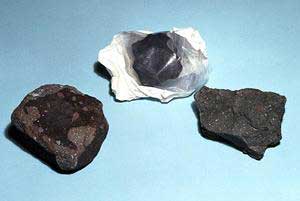Avi Blizovsky

Carbonaceous meteorite. Photo: NASA
Direct link to this page: https://www.hayadan.org.il/diamondplanet.html
The inner planets in the solar system are mostly made of rocks formed from Mars. However, in a different solar system, with a different distribution of the minerals, they may be built from carbon instead of iron. Inside these stars, where the heat is immense, this carbon may form layers of diamonds.
A scaled-down version of such planets lands on Earth all the time in the form of carbonaceous meteorites, which contain various carbon compounds, such as carbides, organic materials and sometimes even diamonds.
The words were said in a presentation presented this week at the conference on the study of planets outside the solar system in Aspen, Colorado.
Carbonaceous planets are formed just like a certain type of meteorites in our solar system, the carbonaceous chondrites, said Dr. Mark Kuchner of Princeton University, who reported this in Aspen together with Dr. Sarah Seager. from the Carnegie Institution in Washington. "These meteorites contain large amounts of carbon components such as carbides, organic materials and graphite and rarely even tiny diamonds. Imagine such a meteorite the size of a planet, and you get a picture of a carbonaceous planet.
Planets like Earth are considered to be derivatives of the gas disk that surrounded the young Sun. In gas clouds that have too much carbon or too little oxygen (which on Earth combines with the carbon to form CO2), the carbon compounds such as carbides and graphite are compressed instead of the silicates, and this explains the existence of the carbonaceous meteorites and suggests the possibility of the existence of carbonaceous planets. Compressed graphite will turn into diamonds at the high pressures that exist within the carbonaceous planets, almost certainly producing layers of diamonds within the planet many kilometers thick.
The planets orbiting the pulsar PSR 1257+12 are a good example of carbonaceous planets, possibly formed from the explosion of a carbon-producing star. So are the planets orbiting stars near the center of the galaxy, which are richer in carbon than the sun on average. Finally, little by little the entire galaxy may become richer in carbon, and in the distant future all the planets that are formed will be carbon planets.
To test his theory, Kuchner suggests waiting for the launch of the Terrestrial Planet Finder (TPF) mission, which NASA is planning for another decade, and which will be able to locate the carbonaceous planets." According to him, the spectra of these planets may contain relatively little water, and instead contain large amounts of carbon monoxide, methane and possibly long chains of carbonaceous compounds synthesized through photochemistry in their atmospheres. The surface of the carbonaceous planets may be covered with layers of long-chain carbon compounds - something like crude oil or tar.
The first TPF telescope, an optical telescope that will be several times larger than the Hubble Space Telescope is scheduled for launch in 2015. The TPF mission was created to search for Earth-like planets and determine whether they might be suitable for life.
For the news in Universe Today
planets outside the solar system
https://www.hayadan.org.il/BuildaGate4/general2/data_card.php?Cat=~~~82248866~~~54&SiteName=hayadan
